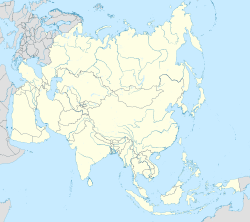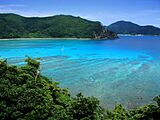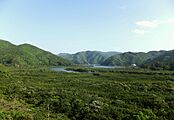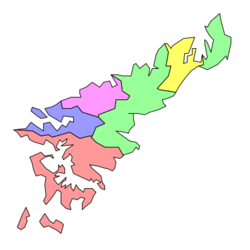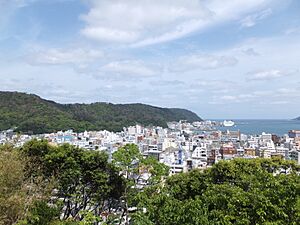Amami Ōshima facts for kids
|
Native name:
奄美大島, Amami Ōshima
Nickname: Uushima
|
|
|---|---|
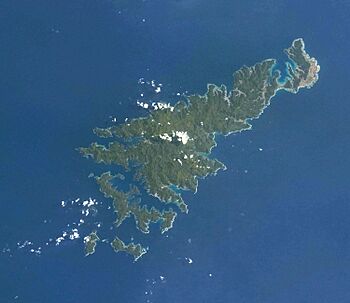
Amami Ōshima
|
|
| Geography | |
| Location | Pacific Ocean |
| Coordinates | 28°19′35″N 129°22′29″E / 28.32639°N 129.37472°E |
| Archipelago | Amami Islands |
| Area | 712.35 km2 (275.04 sq mi) |
| Coastline | 461.1 km (286.51 mi) |
| Highest elevation | 694 m (2,277 ft) |
| Highest point | Yuwandake |
| Administration | |
| Prefectures | Kagoshima Prefecture |
| District | Ōshima District |
| Largest settlement | Amami (pop. 44,561) |
| Demographics | |
| Population | 73,000 (2013) |
| Ethnic groups | Ryukyuan, Japanese |
| UNESCO World Heritage Site | |
| Part of | Amami-Ōshima Island, Tokunoshima Island, northern part of Okinawa Island, and Iriomote Island |
| Criteria | Natural: x |
| Inscription | 2021 (45th Session) |
Amami Ōshima (奄美大島, Okinawan: Uushima (ウーシマ); Amami: Ushima (ウシマ)), also known as Amami, is the largest island in the Amami archipelago. This group of islands is located between Kyūshū and Okinawa in Japan. Amami Ōshima is one of the Satsunan Islands, all of which are part of Kagoshima Prefecture.
The island covers an area of 712.35 square kilometers. About 73,000 people live here. Amami Ōshima is divided into different administrative areas. These include the city of Amami, the towns of Tatsugō and Setouchi, and the villages of Uken and Yamato. A large part of the island is protected within the Amami Guntō National Park.
In 2021, Amami Ōshima became a World Heritage Site recognized by UNESCO. It is part of a larger site that includes several other islands in the region.
Contents
History of Amami Ōshima
It is not fully known when people first settled on Amami Ōshima. Stone tools found on the island suggest that people lived here during the Japanese Paleolithic period. Other ancient items, like pottery, show that the island had regular contact with mainland Japan. This contact happened during the Jōmon, Yayoi, and Kofun period.
The island is mentioned in an old Japanese book called Nihon Shoki in the year 657 AD. During the Nara period and early Heian period, it was a stop for Japanese travelers going to China. Mother of pearl, a shiny material from shells, was an important item exported from the island to Japan.
Between 1571 and 1611, Amami Ōshima was briefly part of the Ryukyu Kingdom. This kingdom was expanding northwards. In 1609, samurai from the Shimazu clan invaded the island. By 1624, it officially became part of their domain. Life under Shimazu rule was hard for the islanders. They were forced to grow sugar cane and pay high taxes. This often led to difficult times and not enough food.
A famous Japanese leader, Saigō Takamori, was sent to Amami Ōshima in 1859. He stayed for two years. His old house is now a museum. After the Meiji Restoration, Amami Ōshima became part of Kagoshima Prefecture. After World War II, the United States occupied the island until 1953. Then, it returned to Japan's control.
In 1974, a large area of the island and the sea around it became the Amami Gunto Quasi-national Park. This park protects nature, including a big mangrove forest. In 2001, there was a naval incident near Amami Ōshima. A North Korean vessel and Japanese Coast Guard ships were involved. The North Korean ship was sunk after a six-hour confrontation. In 2017, the Amami Guntō National Park was officially created. It includes the older park and other land and sea areas.
Geography of Amami Ōshima
Amami Ōshima is the seventh-largest island in Japan. It is located about 380 kilometers south of Kyūshū. It is also about 250 kilometers north of Okinawa. The island was formed by volcanoes. Its highest point is Mount Yuwanda, which is 605 meters above sea level.
The coast of the island is surrounded by beautiful coral reefs. These reefs might have been some of the northernmost in Japan during the last ice age. The East China Sea is to the west of the island. The Pacific Ocean is to the east.
Administration of Amami Ōshima
Amami Ōshima is part of Kagoshima prefecture. It is made up of several local governments called municipalities. These include:
- Amami
- Tatsugo
- Yamatomura
- Usomura
- Part of Setouchi-cho
Climate of Amami Ōshima
Amami Ōshima has a humid subtropical climate. This means it has very warm summers and mild winters. The rainy season usually lasts from May through September. The island also experiences frequent typhoons, which are strong tropical storms.
Animals of Amami Ōshima
Amami Ōshima is home to several rare and endangered animals. These include the Amami rabbit and the Lidth's jay. Both of these animals are now found only on Amami Ōshima and Tokunoshima island. The Amami rabbit is sometimes called a "living fossil." This is because it represents an ancient type of rabbit that has disappeared elsewhere.
The island also has the habu, a venomous snake. This snake can be found throughout the Ryūkyū Islands. Mongooses were brought to the island to hunt the habu. However, they became a problem themselves. More mongooses led to fewer Amami rabbits and other unique species. After the mongoose population grew very large, efforts were made to remove them. By 2024, all mongooses on the island were gone.
Watching humpback whales has become a popular activity in winter. These whales come to the waters around the island. The North Pacific right whale, a very endangered species, has also been seen here. Amami is one of the few places where this whale has been confirmed in recent times. Other whales and dolphins, like Bryde's whales and spinner dolphins, can also be found.
Amami Ōshima is the northernmost place where dugongs are found. These gentle sea creatures are occasionally seen around the island. It is also the only place in Japan where leatherback turtles have been seen nesting.
People of Amami Ōshima
In 2013, Amami Ōshima had a population of 73,000 people. The city of Amami is the largest city on the island. It has 44,561 residents. The city covers an area of 308.15 square kilometers. This means there are about 145 people living in each square kilometer.
Economy of Amami Ōshima
The economy of Amami Ōshima relies on several activities. These include farming, especially sugar cane, rice, and sweet potatoes. Fishing is also important. The island also produces shōchū, a type of Japanese alcohol. The good climate allows farmers to grow two rice crops each year. Tourism, especially during certain seasons, also plays a big part in the economy.
A special traditional craft on the island is making high-quality silk called Ōshima-tsumugi. This silk is mainly used to make kimonos. It is said to be one of the world's three greatest textiles, along with Persian carpets and Gobelin tapestries. Ōshima-tsumugi silk is dyed with mud to give it a unique black color.
Transportation in Amami Ōshima
The port of Naze, located in the city of Amami, is a very important shipping and ferry center for the region.
Amami Airport is at the northern end of the island. It has flights connecting Amami to major Japanese cities like Tokyo, Osaka, Naha, Fukuoka, and Kagoshima. There are also local flights to other Amami Islands. The island has bus routes and roads for getting around.
Language of Amami Ōshima
Two different ways of speaking the Amami language are used on Amami Ōshima. These are the Northern Ōshima dialect and the Southern Ōshima dialect. These dialects are part of the Ryukyuan languages group. In 2005, about 10,000 people spoke the Northern Ōshima dialect. About 1,800 people spoke the Southern Ōshima dialect.
Today, mostly older people on the island speak these dialects. Most younger people speak only Japanese. UNESCO has classified the Amami language, including these dialects, as endangered. This means it is at risk of disappearing. There is also a special village sign language used in the area, called Amami Oshima Sign Language.
Notable people from Amami Ōshima
- Ikue Asazaki – Singer
- Kousuke Atari – Singer
- Meisei Chikara - Sumo wrestler
- Daiamami Genki – Sumo wrestler
- Chitose Hajime – Singer
- Minami Kizuki – Singer
- Motoji Koumei – Kimono retailer
- Kenji Midori – Karateka
- Domingos Chohachi Nakamura – Catholic missionary, who was born in Nagasaki and lived 26 years in Amami Oshima
- Reona - Singer
- Rikki – Singer
- Rena Takeshita – Fashion model
See also
- Amami Guntō National Park
- Battle of Amami-Ōshima



